For heat pump installation halifax services, it's crucial to find a certified installer who understands our Maritime climate. Heat pumps are the ideal solution for our unpredictable weather, providing both heating and cooling from a single system.
With rising energy costs, more families are switching to heat pumps, which can save up to 70% on energy costs compared to electric baseboards. They keep your home comfortable through summer heat and winter storms.
However, the quality of the installation is paramount. Proper sizing, expert installation, and the right equipment for Halifax's climate are the difference between a system that lasts 15+ years and one that fails early. When choosing an installer, look for:
Popular options include ductless mini-splits for homes without existing ductwork and central ducted systems for whole-home comfort. Cold-climate models are essential, designed to handle Nova Scotia winters down to -30°C.
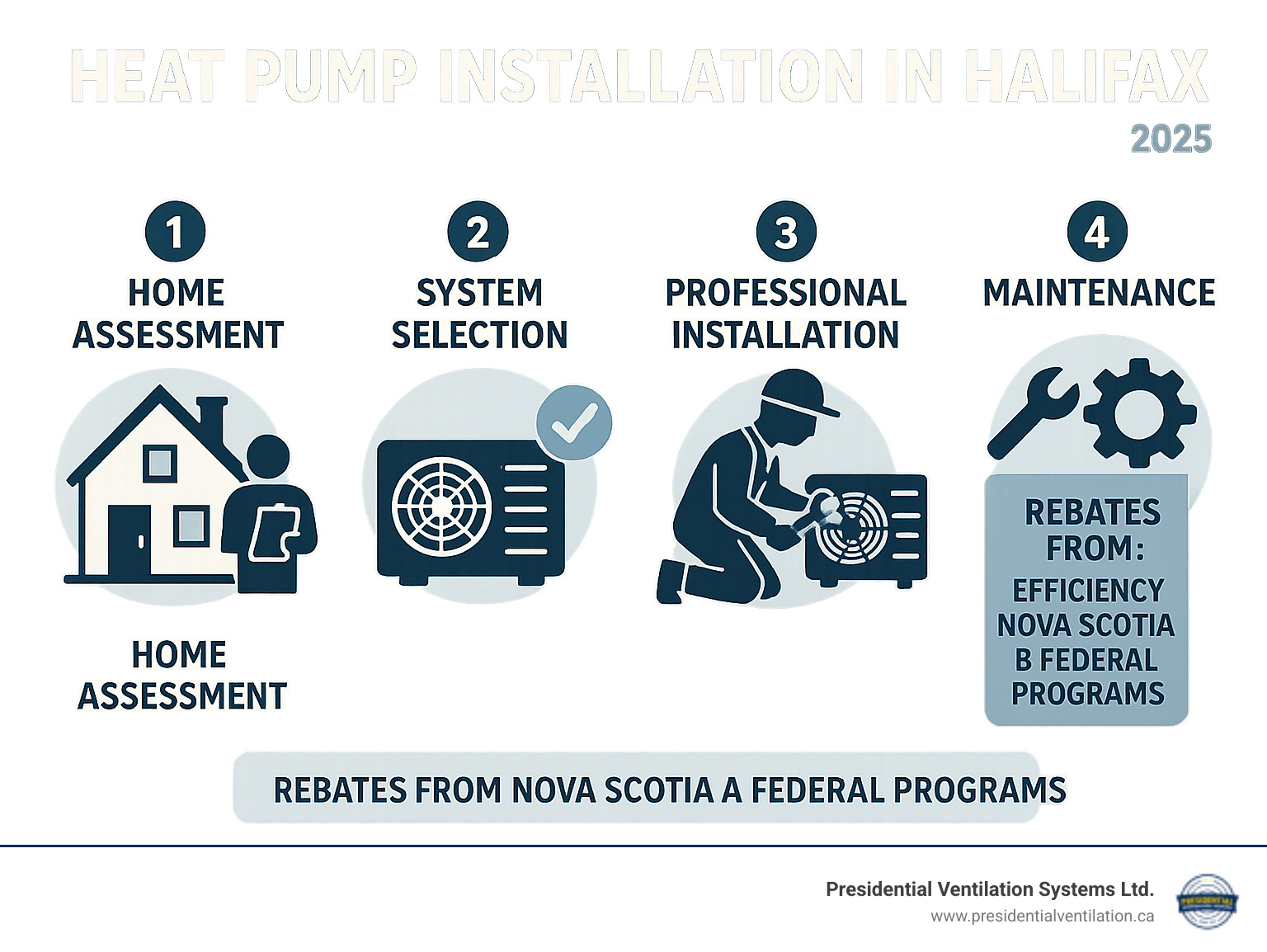
If you're considering a heat pump installation Halifax homeowners are raving about, you're looking at a smart investment. These systems are a game-changer for Maritime living, offering numerous benefits.

Choosing the right heat pump for your Halifax home is like picking the perfect jacket for our weather—it needs to handle everything. For most heat pump installation Halifax projects, air-source heat pumps are the ideal choice. They work by transferring heat between your home and the outside air.
Cold-climate models are essential for Nova Scotia, engineered to provide reliable heat down to -30°C. While less common for residential use due to higher upfront costs, geothermal systems are another option, tapping into the earth's stable underground temperatures for exceptional efficiency.
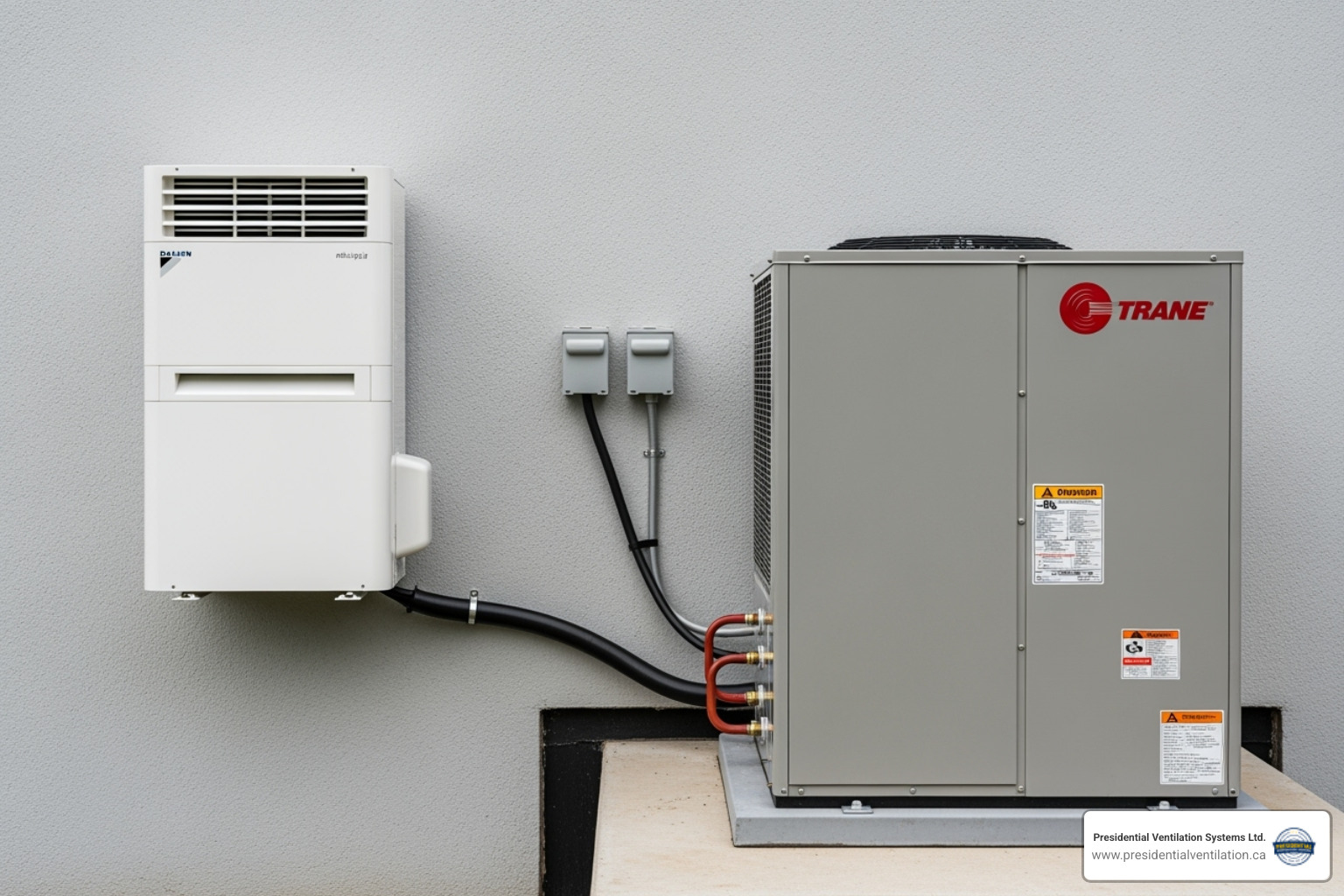
Your biggest decision will likely be between a ductless or ducted system.
Ductless mini-split systems are perfect for homes without existing ductwork, such as those with electric baseboard heat. They consist of an outdoor unit connected to one or more indoor units, allowing for zoned comfort. You can control the temperature in individual rooms, saving energy by not heating or cooling unused spaces. Installation is less invasive and highly flexible. Learn about the Difference Between Ductless and Ducted.
Central ducted heat pumps are ideal if your home already has ductwork from a furnace. They provide whole-home comfort by distributing conditioned air uniformly through existing vents. The indoor components are typically hidden, maintaining your home's aesthetic. Explore our Ducted Heat Pumps Halifax NS services for more information.
FeatureDuctless Mini-SplitCentral Ducted Heat PumpCostLower upfront cost for single zonesHigher upfront cost, but efficient if ductwork existsInstallationQuick, less invasive; no ductwork neededUses existing ductwork; more complex if new ducts neededZoningExcellent; individual control per indoor unitWhole-home uniform temperatureIdeal Home TypeHomes without ducts, additions, targeted areasHomes with existing ductwork for whole-home comfortAestheticsVisible indoor unitsIndoor components typically hidden
Selecting the right brand is about ensuring reliability in Halifax's winters.
When you're ready for a heat pump installation halifax, the quality of the installation is as important as the unit itself. A professional process ensures peak efficiency, longevity, and reliable performance for decades.
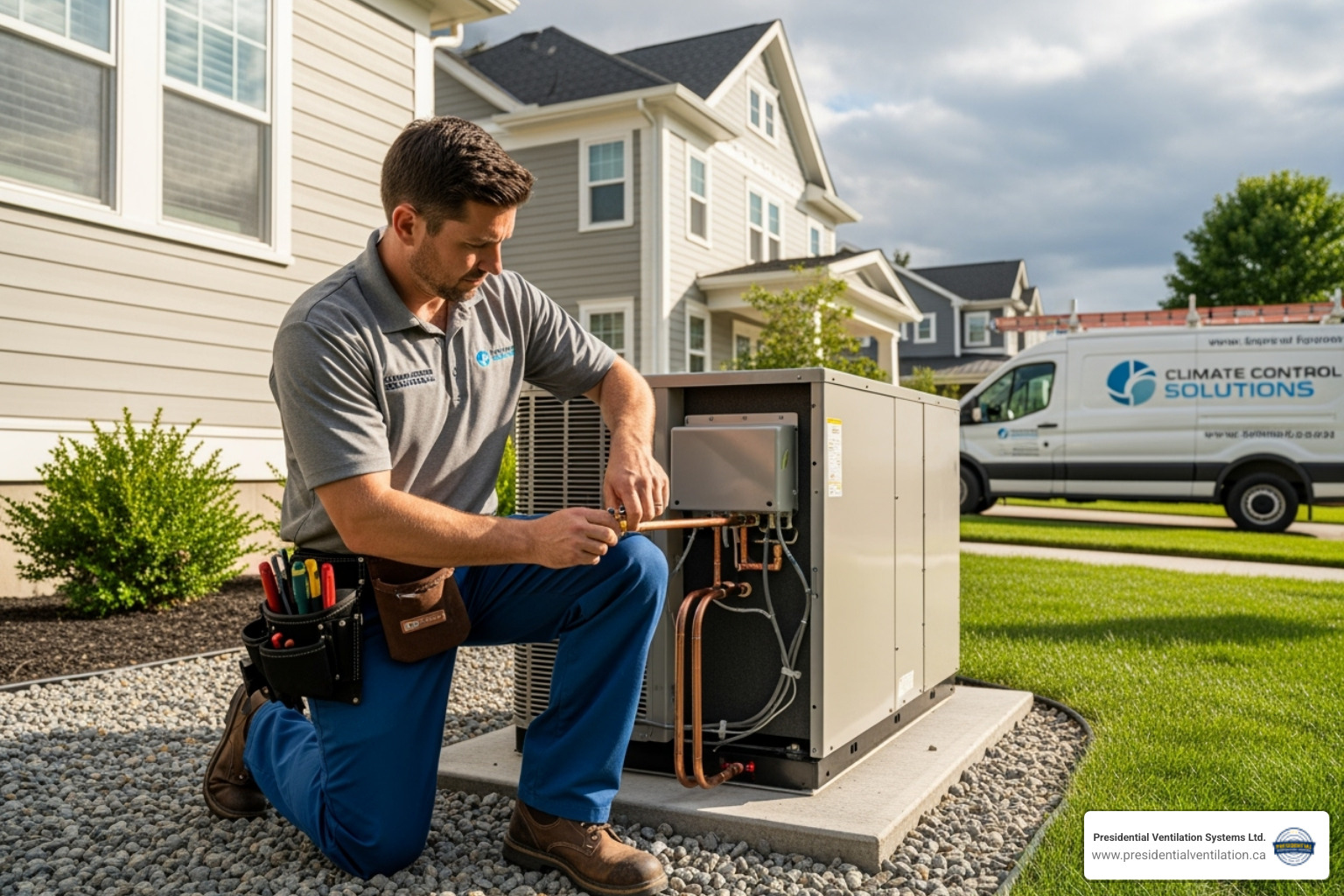
Our professional installation process is clear and straightforward:
The cost of a heat pump installation halifax depends on several factors, including system type and size, your home's layout, and whether any electrical upgrades are needed. A single ductless unit will have a different cost than a multi-zone or central ducted system.
Instead of focusing only on the upfront price, consider the long-term value. Heat pumps often pay for themselves through significant energy savings. You can even Calculate your home energy savings with Nova Scotia Power's tool. We also offer flexible Financing options, including bi-weekly payment plans, to make your investment more manageable.
Selecting the right partner is critical. Here’s what to look for:
After your heat pump installation halifax, you can maximize your investment through government incentives and proper maintenance. This ensures you get the most value while protecting your new system for years to come.

Both provincial and federal governments offer rebates that significantly reduce the upfront cost of a heat pump.
Most programs require a pre- and post-installation energy audit from a certified advisor to verify the improvements. We help you steer this process to ensure you receive all available savings. For a full overview, visit our Heat Pump Rebates Halifax NS page.
Like any major appliance, your heat pump requires regular care to maintain peak performance and efficiency.
DIY Tasks: The most important task is to clean your filters monthly. This simple step prevents restricted airflow and protects your system. Our guide shows you How to Clean Your Ductless Heat Pump Filters. Also, keep the outdoor unit clear of debris, snow, and ice.
Professional Tune-Ups: An annual tune-up from a certified technician is crucial. We inspect and clean coils, check refrigerant levels, and test all components to catch minor issues before they become major problems. Learn about our Heat Pump Tune Up Halifax NS service.
For total peace of mind, consider one of our Maintenance Plan options, which include regular service and priority scheduling. Following our Year Round Heat Pump Care tips will also help protect your investment.
We've answered thousands of questions about heat pump installation halifax. Here are some of the most common ones.
It's a smart question for our Maritime climate. Modern cold-climate heat pumps are incredibly effective, providing reliable heat even in temperatures as low as -25°C or -30°C. For the vast majority of the winter, a high-quality heat pump is all you need.
For extreme cold snaps, you have options. Many ducted systems include auxiliary heat strips that activate automatically. If you have an existing furnace, we can create a hybrid system where the furnace provides supplemental heat only when it's most cost-effective. We'll help you determine the best solution for your home and peace of mind. Learn more in our guide: Do I Need a Backup Source of Heat.
Most installations are surprisingly quick. A typical ductless mini-split system is installed in just one day. A central ducted system usually takes two to three days, as it involves connecting to your existing ductwork.
The timeline can be affected by your home's complexity or if an electrical panel upgrade is required. We provide a clear schedule before we begin, so you know exactly what to expect.
A quality heat pump installation halifax comes with two layers of protection:
To activate the full manufacturer warranty, you must register your product. We guide you through this simple but crucial step. You can even Register My Heat Pump on our website.
Switching to a heat pump is a smart investment in your home's comfort and your wallet. A heat pump installation halifax can reduce energy costs by up to 70%, provide year-round heating and cooling, and improve your indoor air quality. However, these benefits are only realized when the system is sized and installed by experts.
Professional installation is key. An improperly installed unit leads to inefficiency, higher bills, and a shorter lifespan. At Presidential Ventilation Systems Ltd., our certified Red Seal technicians have over 30+ years of combined experience in Nova Scotia's unique climate. As a leading Daikin Comfort Pro Dealer, we install systems engineered for superior cold-climate performance.
We manage every detail, from the initial assessment to the final commissioning, ensuring your installation is smooth and stress-free. Trust our team to deliver the comfort, savings, and peace of mind you deserve.
Ready to upgrade? Let's find the perfect solution for your home.
Contact Us for your Heat Pump Installation in Halifax NS and start your journey to year-round comfort today!



Heat recovery ventilator installation in halifax ns is essential for modern, airtight homes dealing with stuffy air, window condensation, and high energy bills. These homes trap moisture, odors, and pollutants. An HRV system solves this by exchanging stale indoor air with fresh outdoor air while recovering heat from the outgoing stream. This means better air quality without losing warmth or wasting energy, a crucial benefit in Halifax's damp coastal climate where excess humidity can lead to mold and structural damage.
Quick Answer: What You Need to Know About HRV Installation in Halifax
For more comprehensive insights on ventilation solutions, check out our guide to HRV System Benefits, and when you're ready to move forward, our team is here to help with professional installation services.
Without proper mechanical ventilation, modern energy-efficient homes essentially become sealed boxes where cooking odors, pet dander, VOCs from furniture, and excess humidity have nowhere to go. An HRV provides the necessary air circulation to keep your indoor environment fresh and healthy.
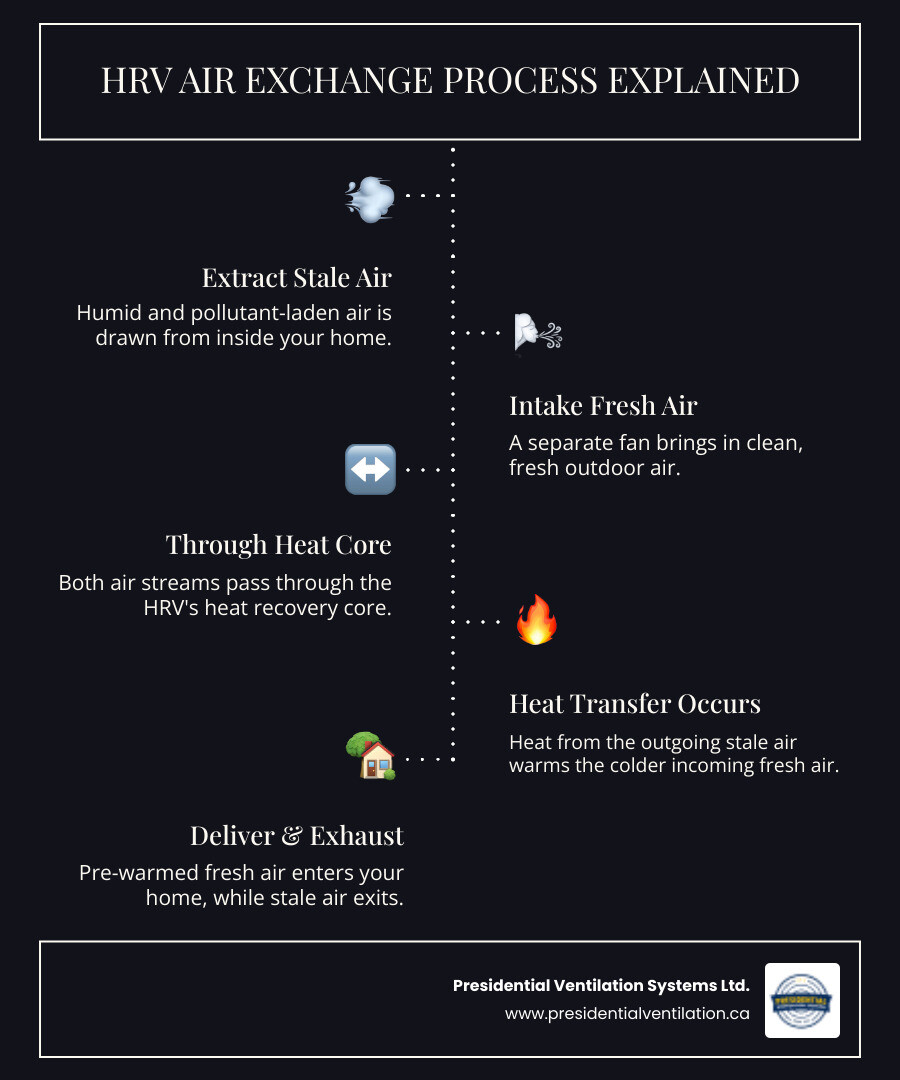
Living in Halifax means dealing with unique indoor air challenges. If your home feels stuffy or you're constantly wiping foggy windows, you're seeing what happens when energy-efficient construction meets our coastal climate. The solution is a heat recovery ventilator installation in Halifax NS, which exchanges stale air for fresh air while recovering heat, working with your heating system, not against it.
Our coastal climate brings constant moisture that gets trapped in tightly sealed homes. When warm, humid indoor air meets cold windows, you get condensation, which can damage window frames and breed mold. Beyond visible moisture, you're also trapping volatile organic compounds (VOCs), carbon dioxide, pet dander, and cooking fumes. An HRV tackles both issues by removing excess humidity and exhausting trapped pollutants, bringing in fresh, filtered air. Our Heating Systems Halifax NS services complement proper ventilation for a truly comfortable home.

An HRV improves indoor air quality, which directly impacts your family's health, especially for those with allergies or asthma. Key benefits include:
By minimizing respiratory irritants, HRVs create an environment where everyone can breathe easier, especially during long winters. Learn more on our Air Exchanger Services Dartmouth page.
HRVs improve air quality while saving you money. Unlike opening a window, an HRV recovers up to 90% of the heat from outgoing stale air and transfers it to the incoming fresh air. This means lower heating costs because your furnace or heat pump doesn't have to work as hard. This also leads to reduced strain on your HVAC system, helping it last longer.
Beyond savings, HRVs create better comfort by providing balanced humidity levels and eliminating that stuffy, stale feeling. The combination of better air, humidity control, and energy savings makes a heat recovery ventilator installation in Halifax NS a smart upgrade. Our Heat Pumps Halifax NS services complement HRV systems for maximum efficiency.
You've likely heard of HRVs and ERVs. Let's clarify the difference and determine which is right for your Halifax home. At its core, an HRV uses a heat exchange core, fans, and filters to efficiently exchange your home's air without wasting heat.
An HRV is a two-way ventilation system. One fan pulls stale, humid air from areas like kitchens and bathrooms, while another fan draws in fresh outdoor air. The two air streams pass through the heat exchange core without mixing. Heat from the warm, outgoing air transfers to the cold, incoming air. This sensible heat transfer means fresh air enters your home pre-warmed. This continuous ventilation process ensures your home always has fresh air without the energy penalty of an open window. For a technical deep dive, you can refer to the Microsoft Word - HRV Guide for Houses- Section 1 - Introduction RC.docx.
The key difference between an HRV and an ERV (Energy Recovery Ventilator) is moisture transfer. An ERV transfers both heat and moisture, while an HRV primarily transfers heat and removes excess humidity. For a heat recovery ventilator installation in Halifax NS, this distinction is critical.
| Feature | HRV (Heat Recovery Ventilator) | ERV (Energy Recovery Ventilator) | Best For Halifax NS Climate |
|---|---|---|---|
| Heat Transfer | Excellent (transfers sensible heat) | Excellent (transfers sensible and latent heat) | Yes |
| Moisture Transfer | Minimal (primarily removes moisture) | Significant (transfers moisture vapor) | No |
| Primary Function | Removes excess humidity and recovers heat | Balances humidity and recovers heat | HRV |
| Climate Suitability | Cold, damp climates with high indoor humidity | Climates with extreme humidity (very dry or very humid) | HRV |
Our coastal climate is already moist; we don't need a ventilation system that retains more humidity. Our damp winters mean most Halifax homes struggle with excess humidity and condensation. An HRV is perfect for our climate because it actively removes that excess humidity while recovering heat. As confirmed by Efficiency Nova Scotia's guide on ventilation, HRVs are the hands-down better choice for Nova Scotia's damp climate suitability.
ERVs are better suited for climates with very dry winters or very humid summers, which isn't our reality in HRM. This makes an HRV the ideal fit for coastal Nova Scotia living. To learn more about how ERVs function in different climates, you can visit our page on Energy Recovery Ventilation Halifax NS.
A professional heat recovery ventilator installation in halifax ns is a detailed process, not a simple plug-and-play job. It begins with a comprehensive assessment of your home's size, layout, and ventilation needs. Proper system sizing is crucial—an oversized unit wastes energy, while an undersized one is ineffective. We then design the most efficient ductwork routes for balanced airflow and quiet operation. For more on our services, visit our HVAC Services Halifax HRM NS page.
A successful installation depends on several factors:
On installation day, our technicians will mount the HRV unit in your basement or utility room. For ductwork, we can install a standalone system with its own ducts (ideal for homes without forced-air heating) or an integrated system that connects to your existing furnace or heat pump ductwork for seamless air distribution. We'll install a user-friendly control panel in a convenient location and a condensate drain line to prevent water damage. The final step is system testing and commissioning, where we measure and balance airflow to ensure quiet, efficient operation and optimal comfort. Learn more in our HVAC Installation Halifax NS 2025 article.

Government programs can help offset the cost of your HRV installation. The Canada Greener Homes Grant provides financial assistance for energy-efficient home retrofits, including HRVs. As an Efficiency Nova Scotia partner, we are familiar with provincial programs that may also offer incentives. We encourage you to explore the Canada Greener Homes Grant information to see what rebates might apply and ask about our current Promotions when you contact us.
Your HRV works 24/7 to keep your air fresh. With proper care, it can reliably serve your home for 15 to 20 years or even longer. This involves simple DIY tasks and knowing when to call a professional.
You can perform several simple tasks to keep your HRV running smoothly:

While DIY maintenance is key, some issues require an expert. Call a professional if you notice:
Our team can diagnose these issues and offers HRV Duct Cleaning to keep your entire system in top shape.
An HRV's 15-20+ year lifespan depends on two factors: proper installation and regular maintenance. A correctly sized and balanced system installed by professionals experiences less wear and tear. Consistent upkeep, including annual professional tune-ups, catches small issues before they become big problems and ensures peak efficiency. Our Maintenance Plan can help you protect your investment. Regular maintenance is also key for energy efficiency, as discussed in our guide on Regular Maintenance Heat Pump Efficiency.
We hear the same questions about heat recovery ventilator installation in halifax ns from homeowners across the HRM. Here are answers to the most common concerns.
Yes, absolutely. Older homes often have inconsistent ventilation and can greatly benefit from an HRV. A professional assessment is needed to determine the best approach. This may involve a standalone system with dedicated ducting (for homes with baseboard heat) or adapting existing ductwork if you have a forced-air system. Our team can design a solution that fits your home's unique character. Learn more in our Air Exchanger Installation Dartmouth Guide.
No, an HRV will not make your house colder. The system's heat recovery core transfers heat from the outgoing stale air to the incoming fresh air. This pre-warms the fresh air before it enters your living spaces, maintaining comfort and improving energy efficiency. You get fresh air without the cold draft.
An HRV can be integrated with any heating system. For homes with a forced-air furnace or ducted heat pump, the HRV can connect to your central ductwork, using the main fan to distribute fresh air. For homes with baseboard heaters or ductless mini-split heat pumps, we install the HRV as a standalone system with its own dedicated ducting. We will recommend the most effective method for your home during our consultation. For more on ducted systems, visit our Ducted Heat Pumps Halifax NS page for additional information.
A heat recovery ventilator installation in halifax ns is about more than just equipment; it's about improving your quality of life. It means waking up to fresh air, saying goodbye to foggy windows, and saving money on energy bills. An HRV is the practical, efficient solution for Halifax's unique coastal climate, actively removing excess moisture while recovering valuable heat.
Choosing the right installer is as important as the system itself. A poor installation can lead to poor performance and lost savings. Professional heat recovery ventilator installation in halifax ns requires expertise in HVAC design, building science, and system balancing.
At Presidential Ventilation Systems Ltd., our certified technicians have over 30 years of experience serving homeowners across the HRM. We properly assess your home, design an efficient system, and ensure it's correctly balanced and commissioned. We can also guide you on available rebates. For a comprehensive solution, explore our dedicated HRV Systems page.
Ready to transform your indoor air quality? Contact Us today to schedule your professional assessment and breathe easier in a healthier, more comfortable home.


Heat recovery ventilator installation in dartmouth ns is becoming essential for homeowners who want cleaner air and lower energy bills. Modern homes in Dartmouth are built to be airtight for energy efficiency, but this means pollutants, humidity, and stale air get trapped inside. Over 50% of homes show visible signs of excess humidity, like condensation on windows or musty smells. Without proper ventilation, you're breathing the same air over and over, along with allergens, odors, and moisture that can lead to mold.
Quick Answer: What You Need to Know About HRV Installation in Dartmouth
An HRV system solves this problem by continuously bringing in fresh air while sending out stale air, all without wasting your heating dollars. The system captures heat from the air leaving your home and transfers it to the fresh air coming in. This means you get a constant supply of clean, filtered air year-round, without cranking up your heating bill or creating cold drafts.
For more on how ventilation systems work in your home, check out our guide on Residential Ventilation Installation Dartmouth NS, or contact us for a professional assessment.
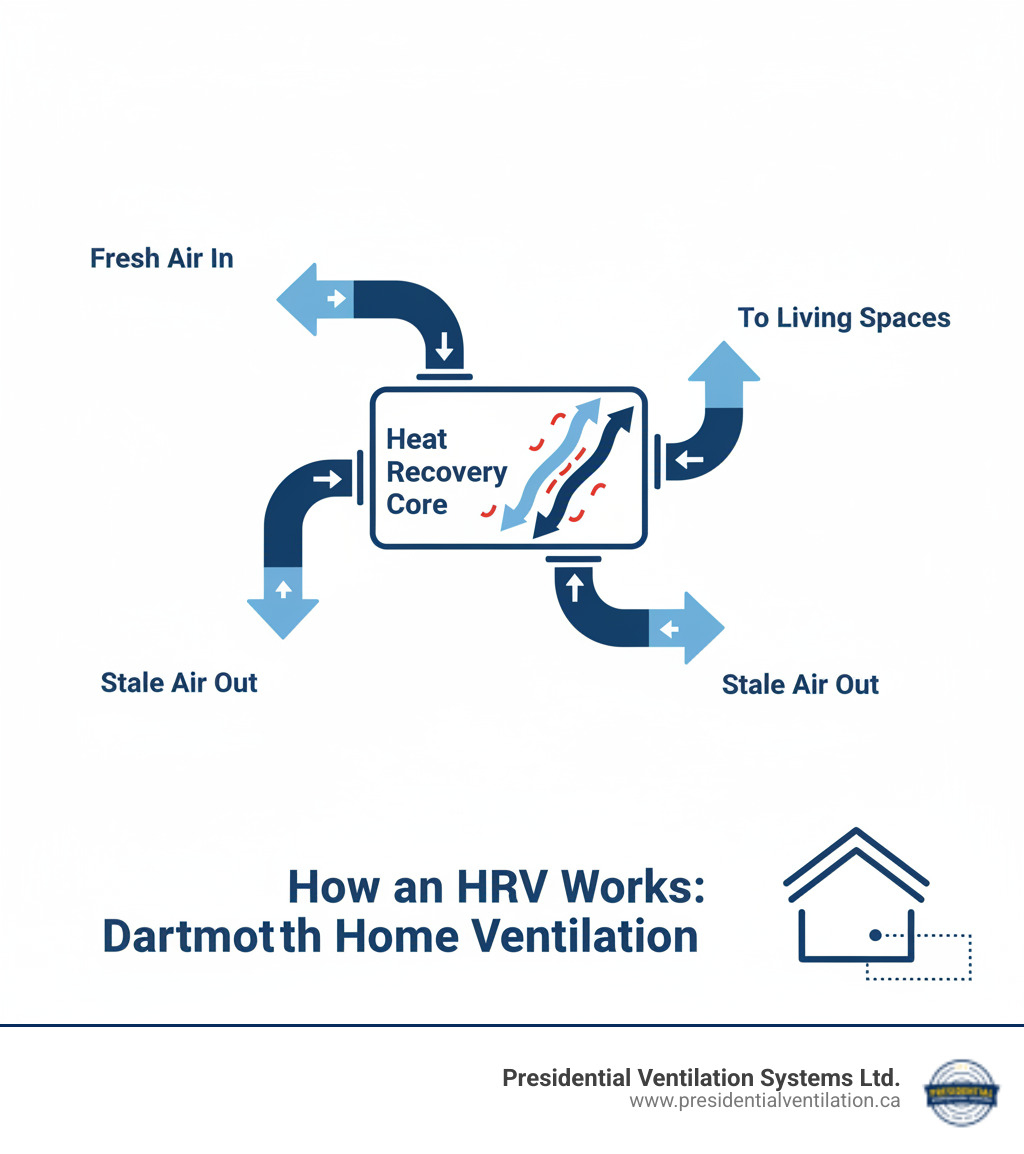
Modern airtight homes are great for energy efficiency, but they also trap pollutants, humidity, and stale air. Without proper ventilation, cooking odors, pet dander, and moisture from showers get stuck inside. In Dartmouth's coastal climate, this is a common problem, with over 50% of homes showing signs of excess humidity.
This is where heat recovery ventilator installation in dartmouth ns makes a difference. An HRV acts like your home's lungs, continuously exchanging stale indoor air for fresh outdoor air. It recovers up to 85% of the heat from the outgoing air, transferring it to the incoming air. This means you get fresh air without high heating costs. Key benefits include:
Pay attention to these signals from your home:
Opening a window seems like a simple solution, but it's inefficient in Dartmouth's climate. In winter, you lose expensive heat, and in summer, you let in hot, humid air. An open window also lets in pollen, dust, and exhaust fumes.
An HRV offers a superior solution:
An HRV invests in your home's efficiency, while an open window simply wastes energy. For more on efficient air exchange, read our Air Exchanger Installation Dartmouth Guide.
Choosing the right HRV system for your Dartmouth home is about matching the unit to your specific needs. Key factors like your home's size, efficiency goals, and our local climate will determine the best fit.

Proper installation is as important as the unit itself.
A professional heat recovery ventilator installation in dartmouth ns is a multi-step process requiring specialized knowledge. Our certified technicians ensure your system is installed correctly for optimal performance and longevity.

Our process includes:
DIY installation is not recommended. Professional installation is essential for:
Yes, HRVs can be retrofitted into older Dartmouth homes and are often highly beneficial, especially after energy-efficiency upgrades like new windows or insulation have reduced natural air exchange.
The retrofitting process requires careful planning. Our team excels at finding creative ductwork routing strategies that preserve your home's character, such as running ducts through closets or existing chases. We assess your home's unique structure and design a system that integrates seamlessly. A professional assessment is the first step to bringing modern ventilation to your older home. Our expertise in Custom Ductwork Design Halifax NS ensures a perfect fit.
To ensure your HRV provides fresh, clean air for its full lifespan of 15 to 20 years or more, regular maintenance is key. Neglecting it can lead to reduced airflow, excessive noise, and poor heat recovery. Most issues are preventable with simple, routine care. As Energy.gov notes, proper maintenance is essential for HVAC performance. You can also explore resources from NRCAN for more information.

Investing in heat recovery ventilator installation in dartmouth ns is more affordable thanks to government incentives. These programs can significantly reduce your initial cost.
Our team can help you steer these rebate programs to ensure your installation qualifies and you maximize your savings.
We hear lots of questions from Dartmouth homeowners about HRV systems, and we're always happy to answer them! Here are some of the most common ones we encounter:
An HRV is your best defense against coastal humidity. It continuously exhausts moist, stale air from areas like kitchens and bathrooms while bringing in drier, fresh outdoor air. This constant exchange prevents condensation on windows, reduces the risk of mold, and keeps your home's humidity at a comfortable level (typically 30-60%).
HRVs and ducted heat pumps are a perfect team. The HRV supplies fresh, pre-conditioned air (warmed in winter, cooled in summer) to the heat pump's return duct. The heat pump's fan then distributes this fresh air throughout your home. This integrated system provides superior air quality and efficient heating and cooling. Learn more about our Heat Pump Services Dartmouth NS.
A professionally installed HRV can last 15 to 20 years or even longer. The key to longevity is quality installation and consistent maintenance. Simple tasks like cleaning filters every 3-6 months, combined with an annual professional tune-up, will protect your investment and ensure it runs efficiently for decades.
Your home should be a healthy sanctuary. A heat recovery ventilator installation in dartmouth ns is the solution for condensation, lingering odors, and stale air. It delivers improved indoor air quality, energy savings through heat recovery, and humidity control to protect your home from mold—all crucial in our coastal climate.
An HRV is a long-term investment in your family's well-being, providing fresh, clean air for 15 to 20 years or more.
For over 30 years, Presidential Ventilation Systems Ltd. has helped Dartmouth homeowners breathe easier. Our Red Seal certified technicians provide expert HRV installation custom to our local climate and your home's specific needs. We design custom ventilation solutions for new builds, upgrades, and older home retrofits.
Ready to experience the difference fresh air can make? Contact us to learn more about our HRV Systems today and let's bring healthier air into your Dartmouth home.